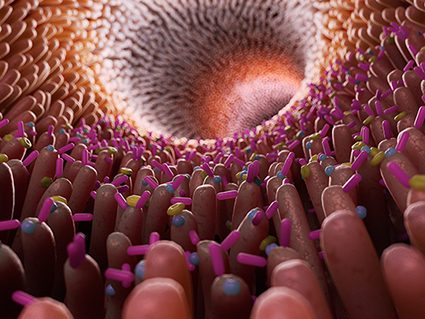Researchers at the University of Alabama at Birmingham (UAB) have provided new insights into how antibiotic use in humans can disrupt the communities of bacteria that reside in our gut systems. The team’s studies showed how new strains of gut microbes emerge and replace pretreatment strains, sometimes only transiently, but sometimes over the longer term. The pattern of strain recovery varied from person-to-person. “As shown from our analysis, the capacity to recover with respect to the number and stability of new strains is specific for each individual,” said Casey Morrow, PhD, research team lead and professor emeritus in UAB’s department of cell, developmental and integrative biology.
“Understanding this recovery pattern, including the occurrence of particular strains following antibiotics, may be an important consideration for long-term health,” Morrow and colleagues concluded in their published paper in Biofilms and Microbiomes. “In the future, the characterization of these individual-specific recovery patterns could also be used to forecast the susceptibility to both endogenous and exogenous microbial pathogens.” The team’s paper is titled, “Individualized recovery of gut microbial strains post antibiotics.”

It’s now possible to use next-generation sequencing technologies to analyze bacterial strain variants without the need for microbial culture. For their study, the researchers used a bioinformatics tool developed at UAB that can assess the strain relatedness of multiple microbes in different samples, to analyze data from two previously described studies. In one of the studies, 18 individuals were given a single antibiotic, cefprozil, for a week. The participants’ fecal samples were collected at a pretreatment timepoint, and again at the end of antibiotic treatment and at three months post-treatment. The second study analyzed 12 individuals who had been given a combination of three antibiotics—meropenem, gentamicin, and vancomycin—this time for four days. In this study, the participants’ fecal samples were collected at pretreatment, again at end of treatment, and at four, 38, and 176 days post-treatment. Data from six control individuals who did not receive antibiotics were also included in the UAB analyses.
The data from the studies were analyzed using the bioinformatics tool, which is called window-based single-nucleotide variant (SNV) similarity, to assess the emergence and relatedness of bacterial strains between different samples as a result of antibiotic therapy. “This study used a strain-tracking bioinformatics tool previously developed by UAB, called window-based similarity single-nucleotide-variant, or WSS, for tracking of individuals’ microbial strains from pretreatment to post-antibiotics treatment,” said Hyunmin Koo, PhD, at the UAB department of genetics and Heflin Center for Genomic Science. Koo led the informatics analysis and is first author on the published paper. In 2017, the UAB researchers used WSS for the first direct demonstration that fecal donor microbes—used to treat patients with recurrent Clostridium difficile infections—remained in recipients for months or years after fecal transplants.
“This technique advances analysis of the impact of antibiotics on the human gut microbiota,” Koo added. “Previous studies of the microbiome had been able to determine an overall taxonomic profile including the relative abundance information of each species, but showed a limitation to distinguish each species at the strain level or track the same strain in each individual at the longitudinal level.”
The results from the newly reported studies showed that strains of the 10 most abundant bacterial species remained stable among the control participants. In contrast, the antibiotic-treated cohorts demonstrated changes to their gut microbiota. Fifteen of 18 individuals who had received single antibiotic treatment demonstrated transient strains that emerged post-treatment but, in turn, were then replaced by the original strain by three months post-treatment. “We noted several instances where there were blooms of new strains (different from the pre-strain) that were transient and eventually replaced by the pre-strain …” the investigators stated. “Most probably, the initial bloom of the new strain is due to the more effective competition for nutrients as compared to the pre-antibiotic strain although it could also be a greater susceptibility of the pre-antibiotic strain to the antibiotics. As the overall microbial community structure recovers, the pre-antibiotic strain regains the competitive edge.”
The changes in microbial strains were more pronounced among the triple-antibiotics individuals, who showed “a significant increase of new strains” when compared with both individuals who had received a single antibiotic, and with the control data sets. The new stains in triple antibiotic-treated individuals persisted for the six months post-treatment analysis timepoint.
The analyses also found that the fraction of transient strains was significantly higher in individuals who had received three antibiotics, compared with single antibiotic administration. These changes were not due to a difference in growth rates, and suggest a long-term change to an alternative, stable microbiome state, Morrow said. “It is possible that as individuals age, with each differing in numbers and cycles of antibiotic treatment, the reservoir of microbial strains is depleted, resulting in an intra-individual recovery pattern for specific microbial strains,” he added.
“Given the importance of the microbiome in human health, we think our results with these data sets can be used to help evaluate microbiome stability under different conditions,” Morrow noted. “For example, we can now provide guidance to clinical investigators to judge the impact of certain treatments for diseases, such as cancer or diabetes, on the gut microbial community that could be significant for evaluation of outcomes. Furthermore, this approach could be applied to a patient’s pre- and post-hospitalization to identify individuals who may need further management of their microbiomes.”



